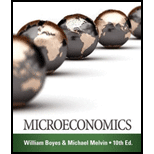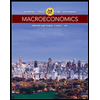
(a)
To explain:
The possible benefits and costs of a commercial policy designed to follow the given goal.
Explanation of Solution
Before saving any job in the industry it must be created first. Importing restrictions may save domestic jobs but at the same time the cost which is to be incurred to the consumers may be greater than the benefits for those who retain their jobs.
Comparative advantage refers to the benefits of producing goods and services at lower
(b)
To explain:
The possible benefits and costs of a commercial policy designed to follow the given goal.
Explanation of Solution
In this policy, people used to believe that the domestic government should take necessary steps to offset the advantage of foreign firms because foreign workers are always willing to work on a very low level of wages. Imposing restrictions will also eliminate the comparative advantage of foreign firms. By doing these, domestic consumers will worse off and undermine the basis of economy efficiency.
Comparative Advantage:
Comparative advantage refers to the benefits of producing goods and services at lower opportunity cost than the other country.
(c)
To explain:
The possible benefits and costs of a commercial policy designed to follow the given goal.
Explanation of Solution
Government revenue is being generated by tariff on trade. There are industrial countries for which income taxes are easy to collect and it rarely justifies tariffs based on the revenue generated for government spending. But there are many developing countries which find income taxes very difficult to levy and to collect tariffs is very easy for them. In developing countries, Observation of trade flows makes tariffs a very popular tax, and for which their revenue requirements may provide a valid justification for their existence.
Comparative Advantage:
Comparative advantage refers to the benefits of producing goods and services at lower opportunity cost than the other country.
(d)
To explain:
The possible benefits and costs of a commercial policy designed to follow the given goal.
Explanation of Solution
The industries which are very critical to the national defense should be protected from foreign competitions so that their existence is ensured. Likewise, proper care must be taken to highly ensure that the national defense arguments are not to be used to protect the countries other than those who are very crucial to national defense. The protection from foreign competition is very necessary so that the key defense related industries should continue to produce. For example, the shipbuilding industry is necessary in war since foreign made ships are not to be used at that time.
Comparative Advantage:
Comparative advantage refers to the benefits of producing goods and services at lower opportunity cost than the other country.
(e)
To explain:
The possible benefits and costs of a commercial policy designed to follow the given goal.
Explanation of Solution
Protecting infant industries is necessary for countries so that when the time is needed to be competitive, they can stand against the rest of the world. Nations are often inclined to protect new industries so that these new industries need adequate time to develop and to establish themselves to be more efficient enough. With the help of this, their costs are even no longer higher than those of foreign rivals. The main motive of such protection is to subsidize the costs. When the infant industry gets maturity and achieves enough size, such protection is withdrawn, and the industry is ready to compete with foreign competitors.
Comparative Advantage:
Comparative advantage refers to the benefits of producing goods and services at lower opportunity cost than the other country.
(f)
To explain:
The possible benefits and costs of a commercial policy designed to follow the given goal.
Explanation of Solution
An industry in which the cost of producing a unit of output fall due to increase in output is produced is an increasing return to scale. Strategic trade policy is intended to provide domestic increasing return to scale with an advantage over there foreign competitors. Opportunity cost falls in some industries with the increased level of output, such an increasing return to scale will require concentrating on production.
Comparative Advantage:
Comparative advantage refers to the benefits of producing goods and services at lower opportunity cost than the other country.
Want to see more full solutions like this?
Chapter 21 Solutions
Microeconomics (MindTap Course List)
- Assume a small open country under fixed exchanges rate and full capital mobility. Prices are fixed in the short run and equilibrium is given initially at point A. An exogenous increase in public spending shifts the IS curve to IS'. Which of the following statements is true? Group of answer choices A new equilibrium is reached at point B. The TR curve will shift down until it passes through point B. A new equilibrium is reached at point C. Point B can only be reached in the absence of capital mobility.arrow_forwardA decrease in money demand causes the real interest rate to _____ and output to _____ in the short run, before prices adjust to restore equilibrium. Group of answer choices rise; rise fall; fall fall; rise rise; fallarrow_forwardIf a country's policy makers were to continously use expansionary monetary policy in an attempt to hold unemployment below the natural rate , the long urn result would be? Group of answer choices a decrease in the unemployment rate an increase in the level of output All of these an increase in the rate of inflationarrow_forward
- A shift in the Aggregate Supply curve to the right will result in a move to a point that is southwest of where the economy is currently at. Group of answer choices True Falsearrow_forwardAn oil shock can cause stagflation, a period of higher inflation and higher unemployment. When this happens, the economy moves to a point to the northeast of where it currently is. After the economy has moved to the northeast, the Federal Reserve can reduce that inflation without having to worry about causing more unemployment. Group of answer choices True Falsearrow_forwardThe long-run Phillips Curve is vertical which indicates Group of answer choices that in the long-run, there is no tradeoff between inflation and unemployment. that in the long-run, there is no tradeoff between inflation and the price level. None of these that in the long-run, the economy returns to a 4 percent level of inflation.arrow_forward
- Suppose the exchange rate between the British pound and the U.S. dollar is £1 = $2.00. The U.S. government implementsU.S. government implements a contractionary fiscal policya contractionary fiscal policy. Illustrate the impact of this change in the market for pounds. 1.) Using the line drawing tool, draw and label a new demand line. 2.) Using the line drawing tool, draw and label a new supply line. Note: Carefully follow the instructions above and only draw the required objects.arrow_forwardJust Part D please, this is for environmental economicsarrow_forward3. Consider a single firm that manufactures chemicals and generates pollution through its emissions E. Researchers have estimated the MDF and MAC curves for the emissions to be the following: MDF = 4E and MAC = 125 – E Policymakers have decided to implement an emissions tax to control pollution. They are aware that a constant per-unit tax of $100 is an efficient policy. Yet they are also aware that this policy is not politically feasible because of the large tax burden it places on the firm. As a result, policymakers propose a two- part tax: a per unit tax of $75 for the first 15 units of emissions an increase in the per unit tax to $100 for all further units of emissions With an emissions tax, what is the general condition that determines how much pollution the regulated party will emit? What is the efficient level of emissions given the above MDF and MAC curves? What are the firm's total tax payments under the constant $100 per-unit tax? What is the firm's total cost of compliance…arrow_forward
- 2. Answer the following questions as they relate to a fishery: Why is the maximum sustainable yield not necessarily the optimal sustainable yield? Does the same intuition apply to Nathaniel's decision of when to cut his trees? What condition will hold at the equilibrium level of fishing in an open-access fishery? Use a graph to explain your answer, and show the level of fishing effort. Would this same condition hold if there was only one boat in the fishery? If not, what condition will hold, and why is it different? Use the same graph to show the single boat's level of effort. Suppose you are given authority to solve the open-access problem in the fishery. What is the key problem that you must address with your policy?arrow_forward1. Repeated rounds of negotiation exacerbate the incentive to free-ride that exists for nations considering the ratification of international environmental agreements.arrow_forwardFor environmental Economics, A-C Pleasearrow_forward




 Microeconomics: Private and Public Choice (MindTa...EconomicsISBN:9781305506893Author:James D. Gwartney, Richard L. Stroup, Russell S. Sobel, David A. MacphersonPublisher:Cengage Learning
Microeconomics: Private and Public Choice (MindTa...EconomicsISBN:9781305506893Author:James D. Gwartney, Richard L. Stroup, Russell S. Sobel, David A. MacphersonPublisher:Cengage Learning Macroeconomics: Private and Public Choice (MindTa...EconomicsISBN:9781305506756Author:James D. Gwartney, Richard L. Stroup, Russell S. Sobel, David A. MacphersonPublisher:Cengage Learning
Macroeconomics: Private and Public Choice (MindTa...EconomicsISBN:9781305506756Author:James D. Gwartney, Richard L. Stroup, Russell S. Sobel, David A. MacphersonPublisher:Cengage Learning





